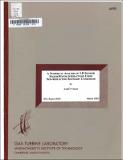A numerical analysis of 3-D inviscid stator/rotor interactions using non-reflecting boundary conditions
Author(s)
Saxer, André P. (André Pierre)
Download26759376.pdf (13.42Mb)
Other Contributors
Massachusetts Institute of Technology. Gas Turbine Laboratory
Metadata
Show full item recordAbstract
This dissertation presents a method for the computation of three-dimensional inviscid, transonic steady and unsteady flows, primarily in axial flow turbines. The work is divided into two major contributions. The first is an algorithm for the solution of the 3-D Euler equations which incorporates a second-order accurate numerical smoothing for non-uniform grids and steady-state non-reflecting boundary conditions. Fourier analysis applied to the linearized Euler equations is used to develop novel quasi-3-D non-reflecting boundary conditions at the inflow/outflow and at the stator/rotor interface. The accuracy, effectiveness and robustness of the boundary condition formulation is demonstrated through several subsonic and transonic test cases and through comparison with the standard 1-D formulation. The second contribution consists in the study of three specific flow phenomena occurring in an axial flow turbine. First, the steady-state effects of an inlet spanwise stagnation temperature gradient in a transonic stage are analyzed. The mechanism for the migration of the temperature as well as the extent of the non-uniformity are assessed. Then, the secondary flow produced by a combined thermal and vortical inlet distortion on a downstream moving rotor is studied. The extent of the radial mixing for steady and unsteady flow is assessed as a function of the strength of the inlet disturbance. The third case is an analysis of the steady, unsteady and time-averaged flow fields in a highly loaded industrial transonic turbine stage. In particular, the unsteady shock interaction due to the impact of the stator trailing edge shock wave off the downstream rotor is studied. From the last two cases it is concluded that in many aspects the time-averaged results are extremely close to the steady-state values, even with strong unsteady shock interaction. For each case the mechanisms for the creation of the secondary flow and deviations from a steady, uniform inlet conditions flow field are presented and analyzed.
Description
March 1992 Includes bibliographical references (pages 230-239)
Date issued
1992Publisher
Cambridge, Mass. : Gas Turbine Laboratory, Massachusetts Institute of Technology, [1992]
Series/Report no.
GTL-209GTL report #209